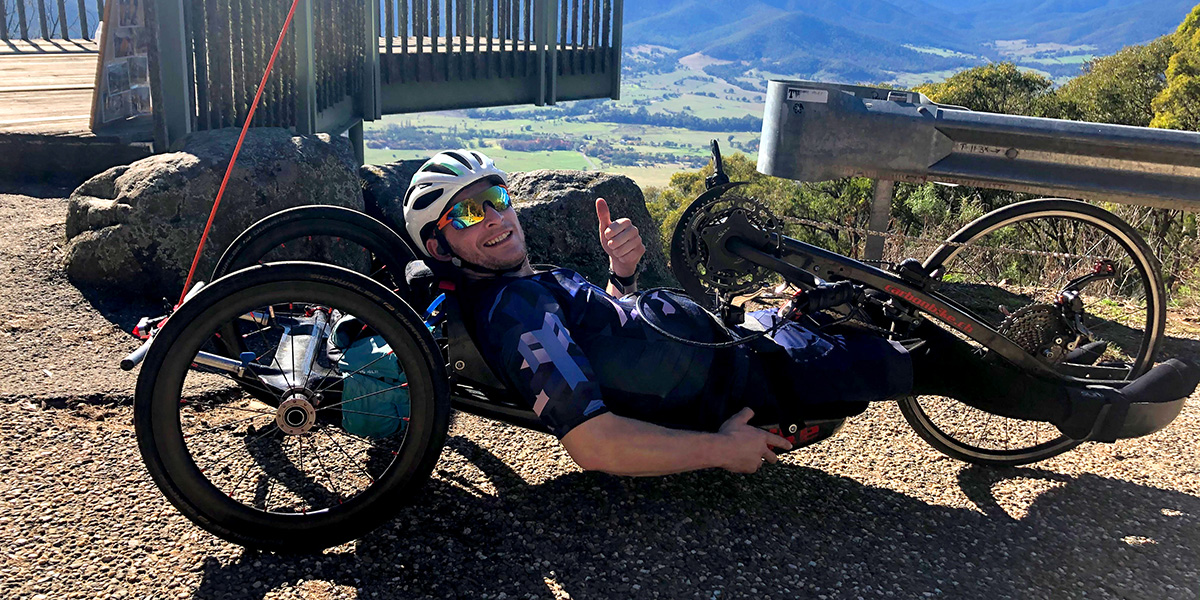I am a T2 paraplegic and have been using a wheelchair for coming up on 11 years now. I had spent time racing as a H3 hand cyclist, and was on average training 7-10 hours a week. I had ridden up many mountains, and had completed the gruelling Seven Peaks challenge.
The Seven Peaks requires riding by road from the foot of each mountain up to seven Victorian ski fields, among them Mt Hotham, Mt Buffalo, Dinner Plain, and Falls Creek. I was also studying to be a personal trainer, and I am a peer mentor with AQA.
Compartment syndrome
On 6 September last year, when Melbourne was in a harsh lockdown, I woke up feeling slightly off from having downed a few drinks the night before (but I think something else was going on). After showering I fell when transferring to my wheelchair, and then, feeling extremely hot, crawled to my room to cool down. As I was away from my wheelchair, I was trying to cool down while leaning with a lot of pressure on my right arm and feeling horrible.
At that moment I decided I would do everything in my power to get back to my full strength, no matter how long it took.

I started to crawl back to my wheelchair, very slowly. Luckily my dad showed up, picked me up, put me in bed, and called an ambulance. After the ambulance arrived, I blacked out.
I woke about two weeks later from a coma, not knowing what the hell was going on. I was aware I had dreamt the craziest dreams you could imagine, all involving those around me dying.
Once I regained my sense of awareness, I asked all the specialists what had happened to me. They explained that I had developed compartment syndrome, from placing so much stress for so long on my right arm.
Problems, multiplying
Compartment syndrome is a dangerous condition where swelling occurs within a muscle compartment, placing pressure on nerves and blood vessels. To release the pressure, multiple incisions needed to be made in the sheath enclosing the compartment. These incisions released toxins into my body, which caused major organs to shut down. I needed a tracheostomy, at least six surgeries on my bowels, multiple surgeries on my right arm, and to top it off dialysis – and I developed a beloved pressure sore.

After spending around 70 days in intensive care at the Austin Hospital, I was transferred to the 3 North spinal ward, which I had spent time in when I suffered my spinal cord injury back in 2010. I remember looking in the mirror for the first time there and thinking how small I looked – how much my muscle condition had deteriorated – and that I wanted so badly to be back to my strong, fit self.
A long climb ahead
From there I came up with the idea of the 60-day challenge: to train and push myself as hard as I could for 60 days, with the aim of climbing a mountain again. I thought that I could also raise money to improve the Royal Talbot Rehabilitation Centre, so that others facing adversity could recover in a better environment. After spending a month or so in 3 North I was transferred to Royal Talbot, where I was to undergo serious work to rebuild my strength. Upon arriving I saw many familiar faces in staff who had been there during my first stay, which was a comforting feeling.
Along my rehab journey I made a lot of friends with staff and patients. The hardest thing, I would say, when having to go through rehab a second time, is knowing what you had been capable of, and having the muscle memory for things like transferring, pushing a wheelchair, and wheelchair skills. Due to losing all my strength I was not able to do any of this, which was incredibly frustrating: going from being completely independent to almost completely reliant on others.

From day one in rehab, I got the okay from the physio to be in my own wheelchair, which made life so much easier than using other wheelchairs that were not suited to me.
Two weeks after arriving at rehab I suffered a terrible urinary tract infection, and was taken to emergency. I was stabilised over one day in emergency, spent another couple of days in intensive care, went back to 3 North for a few more days, and then back to rehab again.
Rebuilding
I spent a further three months in rehab, where I worked hard to regain my strength and independence. I worked in the gym three times a week and was on the arm cranks five days a week, building up my time each week. I had physio and OT sessions three or four days a week. Even though it was hard having to start from next to nothing, I was lucky the one thing I had to do was the thing I am good at: working out and pushing myself to the limit.
I am so grateful for the regular peer support visits from AQA staffers Josh Hose and Naz Erdem, who are also great mates, which helped me to take my mind off things.

Mentor muscle memory
While I was in rehab I found myself sliding into the mentor role again myself, as I have so much experience of living with a spinal cord injury. I had a lot of advice to give to other patients, and in turn they helped me by being such amazing and special people. I couldn’t imagine going through this experience without the amazing nurses, doctors, patient services assistants, physiotherapists and occupational therapists at the Austin and Royal Talbot.
Sixty days after I left rehab, I made good on my 60-day challenge and rode the 42km from Omeo to Dinner Plain near the top of Mount Hotham. Reaching the summit was utterly satisfying after all the hardship and turmoil I had been through. I also raised $5600 dollars for Royal Talbot.
I have managed to get my transfers back to where they were previously, and I train in my handcycle at least 10 hours a week and do two gym sessions on top of that. I am striving to get back to my old form, and set my sights on bigger and better things
- September 21, 2021




